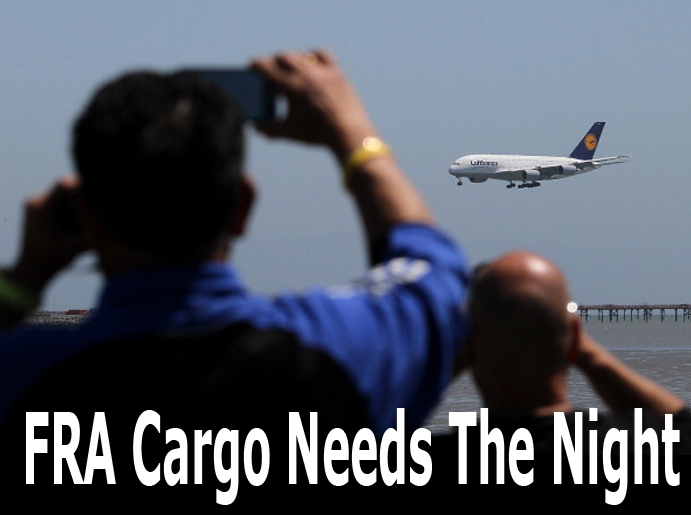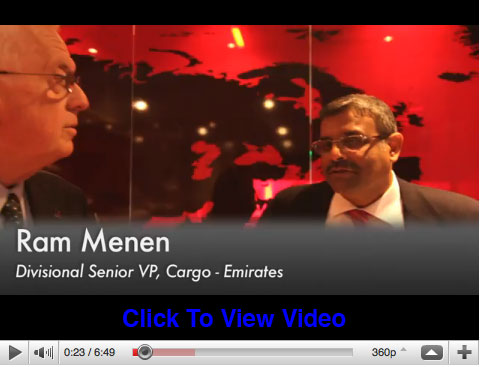
Frankfurt Special . . . Lufthansa opens San Francisco A380
service from Frankfurt this past May. Carrier serves both New
York & Frankfurt daily with A380s.
|
 Lufthansa
Cargo’s helm, Karl Ulrich Garnadt, (right) made his point very
clear: “Without air freight, there will be no global economy.”
At least, not the same one the world is used to today. This was the
widespread consensus among the 220 participants that attended the recent
Frankfurt meeting on “Mobility & Logistics,” organized
by German newspaper Die ZEIT. In a panel discussion, Garnadt went on
to say that his carrier applied for no more than twelve flights on average
each night to and from Frankfurt, the carrier’s main gateway of
operation during the upcoming winter schedule. Lufthansa
Cargo’s helm, Karl Ulrich Garnadt, (right) made his point very
clear: “Without air freight, there will be no global economy.”
At least, not the same one the world is used to today. This was the
widespread consensus among the 220 participants that attended the recent
Frankfurt meeting on “Mobility & Logistics,” organized
by German newspaper Die ZEIT. In a panel discussion, Garnadt went on
to say that his carrier applied for no more than twelve flights on average
each night to and from Frankfurt, the carrier’s main gateway of
operation during the upcoming winter schedule.
“In comparison to our original 43
requested movements, this can’t be called much,” he said.
LH Cargo needs this minimum of 12 flights to guarantee customers the
flow of their goods on selected transcontinental routes, including the
rapid transfer of transit shipments in the lower compartments of passenger
aircraft. This highly sophisticated and tight-knit supply chain is in
danger, however, and might be torn apart soon. The reason for this is
a possible night flight curfew that might be imposed at Rhein-Main airport
by the country’s highest administrative court.
 The upcoming verdict is hanging like the sword of Damocles over the
heads of LH Cargo and the entire cargo community. If this curfew is
imposed by the judges to “better protect the airport’s neighbors
from further noise emissions,” the consequences will be severe,
says Karl-Friedrich Rausch, (left) Deutsche Bahn’s executive board
member and head of logistics giant DB Schenker.
The upcoming verdict is hanging like the sword of Damocles over the
heads of LH Cargo and the entire cargo community. If this curfew is
imposed by the judges to “better protect the airport’s neighbors
from further noise emissions,” the consequences will be severe,
says Karl-Friedrich Rausch, (left) Deutsche Bahn’s executive board
member and head of logistics giant DB Schenker.
“Given that situation, the more
than 50 million euros we invested in good faith, that there would be
24/7 uninterrupted traffic flows into our facility at Frankfurt’s
CargoCity South, was wasted money.” Plan B then comes into effect:
cargo flows will be trucked from German airports to Amsterdam, Paris
or Liege and consolidated there as these places offer continuous operation
day and night.
Last year, Schenker accounted for 180,000
tons shipped via Frankfurt. “These are big volumes that mostly
need freighter lift to be moved. Lower deck capacity isn’t sufficient
for transporting the majority of these goods,” Herr Rausch stated.
But is it really necessary to fly in flowers
from, say, Ecuador or Kenya to Europe, especially with greenhouse emissions
and the global warming aspect? This was a key question raised during
a panel session. Answered Garnadt: “We are flying this produce
due to broad public demand. No more, no less. If not done by Lufthansa
Cargo, others would step in right away to take over the business.”
  Looking
at the CO2, balance he added that the carbon footprint of flowers grown
and fertilized in the Netherlands is 6 percent higher compared to those
produced and harvested in Kenya. Environmentalists are not aware of
this fact, however, or at least don’t mention it when questioning
the air transport of lilies, roses and other floral African or Latin
American produce. William Flynn, (left) CEO of Atlas Air Worldwide Holdings,
Inc., pointed out that consumer trends can change but this takes time. Looking
at the CO2, balance he added that the carbon footprint of flowers grown
and fertilized in the Netherlands is 6 percent higher compared to those
produced and harvested in Kenya. Environmentalists are not aware of
this fact, however, or at least don’t mention it when questioning
the air transport of lilies, roses and other floral African or Latin
American produce. William Flynn, (left) CEO of Atlas Air Worldwide Holdings,
Inc., pointed out that consumer trends can change but this takes time.
A fast reduction of aviation greenhouse
gases could also be achieved by offering the industry sufficient airport
capacity, thus avoiding planes that wait in holds for landing permission.
Not only does this unnecessarily pollute the air, but it also costs
carriers like British Airways, Lufthansa and Air France-KLM a fortune,
sending their kerosene bills going through the roof.
“What we badly need is a more intelligent
utilization of the existing infrastructure,” suggested Deutsche
Post’s CEO Frank Appel. As example, in London Heathrow, DP’s
logistics pillar, DHL Express, bundles all shipments for retailers in
Heathrow’s passenger terminals, in a sorting and distribution
center three miles outside the airport. From there the goods are trucked
to the retailers at certain hours. This avoids jams, reduces pollution
and noise, and guarantees timely delivery.
In Germany “we have plenty of infrastructure,
but we could use it better than we’ve done so far,” Appel
said. Airports are equipped with runways, aprons, terminals and cargo
facilities. To build all this has cost taxpayers a lot of money. “So
why are most of them restricted to operate only 15 or 16 hours per day?”
he asked. This is a waste of infrastructure and money. At least the
big gateways like Frankfurt, for instance, “should allow traffic
around the clock,” urged the Hamburg-born manager. There was nobody
in the conference room who objected to his sentiments.
Heiner Siegmund
|




